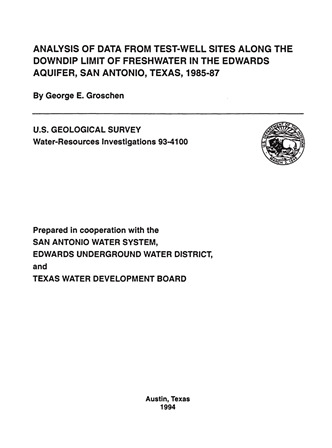Analysis of Data from Test-Well Sites along the Downdip Limit of Freshwater in the Edwards Aquifer, San Antonio, Texas, 1985-87

| Author | Groschen GE (in cooperation with the San Antonio Water System, Edwards Underground Water District, and Texas Water Development Board) |
| Year | 1994 |
| Description | Geochemical and hydrochemical study of the Edwards Aquifer downdip area and saline-freshwater interface in the San Antonio area |
| Report Number | USGS WRIP 93-4100 |
| Publisher | US Geological Survey |
| Location | Edwards Aquifer, Balcones Fault Zone, San Antonio Segment, Downdip |
| Cover | View Download |
| File | View Download |
| Summary |
|
Many researchers have studied the downdip limit of freshwater in the Edwards aquifer or various aspects of the saline-water zone and its relation to the freshwater zone. These studies were summarized and used to synthesize a consistent hydrologic and geochemical framework from which to interpret data from field studies. The concept derived from the previous work on the downdip limit of the freshwater zone is that fresh recharge water entered the aquifer and developed a vast flow system controlled by barrier faults. Some recharge water flows into the saline-water zone rather than toward major freshwater discharge points. The water that enters the saline-water zone continues to dissolve gypsum and dolomite, and calcite precipitates out of the water. This process of dedolomitization has helped to develop the large secondary porosity of the freshwater zone as the downdip limit of the freshwater zone progressively moved downdip in recent geologic time. The drilling of test holes and installation of monitoring wells began in 1985 and helped to define the downdip limit of the freshwater zone at one location. Dolomite was found in greater amounts in rocks from the saline-water-zone test hole than in rocks from the freshwater-zone test hole. Other mineralogic and lithologic contrasts between the saline-water-zone test hole and the freshwater-zone test hole support the conceptual model of dedolomitization. Geophysical logs and test-hole survey logs helped to define the stratification of freshwater and associated altered rock textures, secondary porosity development, and water chemistry in the freshwater-, saline-water-, and transition-zone test holes. The differences in actual measured head among the seven completed monitor wells varied over time, especially during periods of substantial water use. The water levels in two monitor wells completed at the freshwater zone (siteD; wells Dl and D2) responded quickly and strongly to withdrawals. In the transition zone (site C; wells C1and C2), the water level in the shallow monitor well (C1) completed in a cavern responded quickly, but because it was farther from the water-supply wells near site D, it did not respond as strongly to changes in withdrawals at the nearby well field. The water levels in the three saline-water wells at site A (A1, A2, and A3) and the deep site C well (C2) were less responsive to stresses relative to the water-level changes in the freshwater wells (D1, D2, and C1). Large amounts of freshwater were produced from the upper 300 to 350 feet of the aquifer in the freshwater zone (site D). Water produced from below this interval was as saline as that from the saline-water zone (site A). The cavern near the top of the aquifer in the transition zone (site C) produced large amounts of freshwater. The freshwater produced from the cavern was of a different geochemical type than the water from the other wells. The saline-water-zone test hole (site A) produced small amounts of water having specific conductance generally about 5,800 to 6,200 microsiemens per centimeter at 25 degrees Celsius. A consistent trend in the water quality was not detected in the monitor-well data for July 1986-April 1987. This was caused, in part, by the average to above-average rainfall and by the lack of large withdrawals during the period. The water quality of samples from several of the wells was similar to the water quality determined by a previous study of the area. Geochemistry of the oil- or gas-well brines from downdip in the saline-water zone had slight resemblance to the geochemistry of the water at the downdip limit of freshwater; updip flow of saline water toward the freshwater zone was not indicated. |
Search for Documents
Advance Search
Explore EAA's Scientific Reports
- All Reports
- Hydrology and Hydrogeology
- History
- Groundwater Recharge, Recharge Zone
- Groundwater Movement
- Geomorphology and Caves
- Weather Modification
- Geology
- Water Use and Conservation
- Geochemistry
- Water Resources Planning and Management
- Floods and Drought
- Water Quality
- Climatology
- Surface Water / Groundwater Relationship
- Biology
- Springs, Groundwater Discharge
- Archaeology
- RZ Protection
- Aquifer Levels
- Remote Sensing
- Precipitation
- Overview Studies
- Modeling
